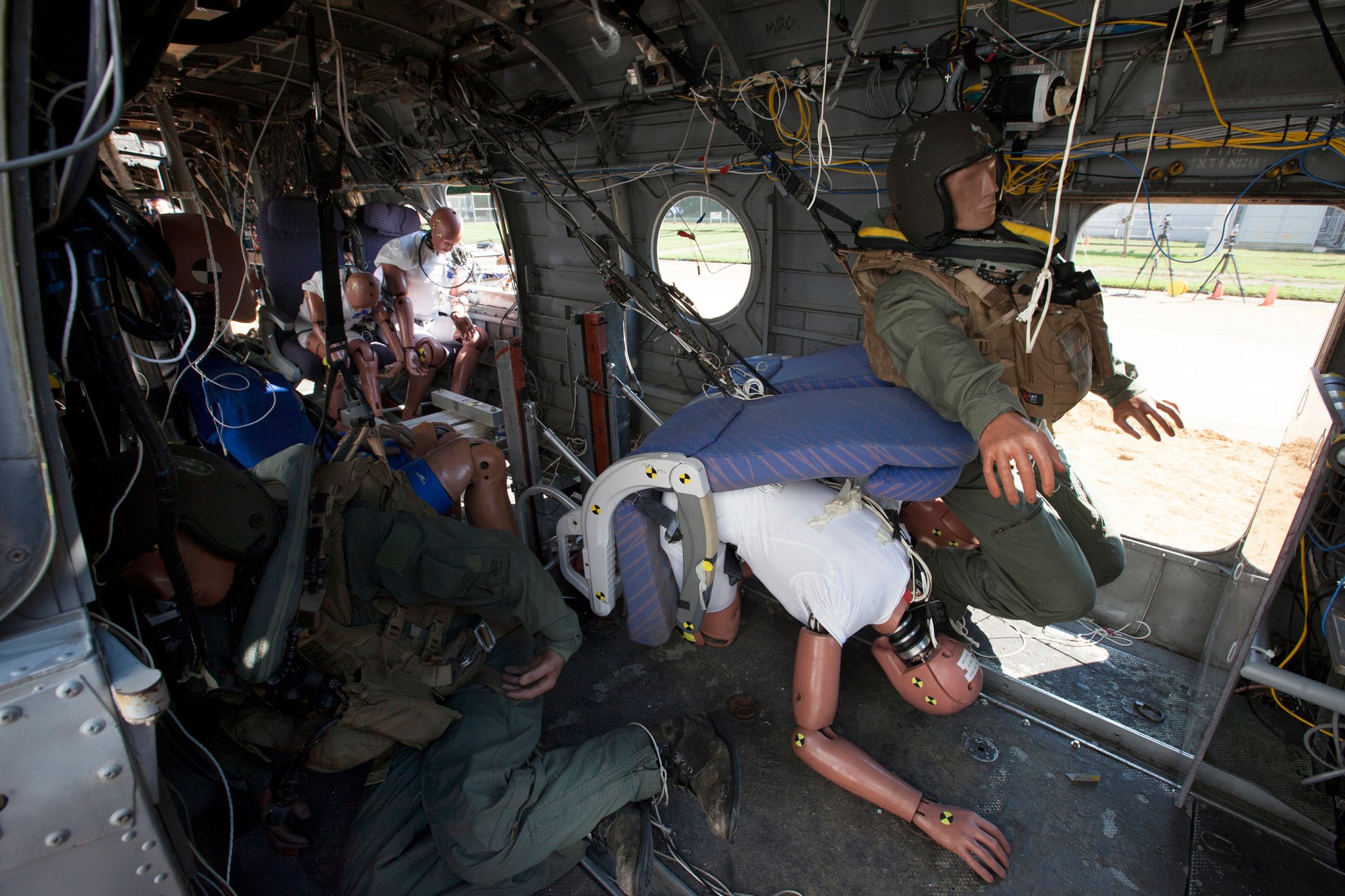It’s not every day that you see a black and white polka-dotted helicopter hanging in the air, suspended by cables.
But then not every day is a crash test day at NASA’s Langley Research Center in Hampton, Virginia.
NASA researchers and others from the military and national and international government agencies spent more than three years preparing for less than 10 seconds. That’s about how long it took for a 45-foot-long former Marine helicopter to fall 30 feet into a bed of dirt during the Transport Rotorcraft Airframe Crash Testbed (TRACT 2) full-scale crash test at NASA Langley’s Landing and Impact Research (LANDIR) facility.
“We chose soil because if you look at the mishap data the majority of the mishaps don’t occur on prepared surfaces, like concrete ” said Martin Annett, lead test engineer. “The helicopter plowed into the dirt at about 30 miles an hour – a severe but survivable crash according to civilian and military standards.”
Inside were 13 instrumented crash test dummies and two non-instrumented manikins. They were strapped in as cables hauled the helicopter fuselage into the air and then swung it to the ground, much like a pendulum. Just before impact pyro-technic devices released the suspension cables from the helicopter to allow free flight.
The test mimicked a similar one done last summer, but this time the helicopter stopped abruptly and only slid a few feet. “Because it came to an abrupt stop there’s a lot more load or jerking motion that gets imparted in the longitudinal direction, forward and backward,” said Annett. “One of the reasons that we do these types of tests is that we learn things when you drop them. You can design the test. Then you put the experiments into a full-scale helicopter in a combined-loading – horizontal and vertical – environment and they behave completely differently.”
NASA and the Australian Cooperative Research Center for Advanced Composite Structures developed and installed three energy absorbing composite material concepts under the passenger floor for this test. That was in addition to other experiments designed to evaluate crashworthy concepts, including seats, restraints and the type of crash test dummies used to certify equipment inside aircraft.
“We removed the metallic floors and added two custom designed and built in-house composite subfloors and an Australian-designed subfloor,” said test engineer Justin Littell. “Then we put a window, made out of clear polycarbonate, in the floor and actually focused three of the high speed cameras through the floor into the subfloor to see how these composite energy absorbers crush during the impact. This is the first time this has been done to my knowledge.”
The cameras worked well, recording an unexpected motion. “One of the things we noticed was there was an excessive shearing action that almost slipped the entire floor, instead of crushing the subfloor like we anticipated,” said Annett.
Almost 40 cameras inside and out and computers on board with 350 data channels recorded every move of the 10,500-pound fuselage and its “passengers.” Even the helicopter’s unusual black and white speckled paint job contributed to the camera data collection. It was for a technique called full field photogrammetry. High-speed cameras filming at 500 images per second tracked each dot, so after the drop researchers can plot and see exactly how the fuselage buckled, cracked or collapsed under crash loads.
Just as is often in real life, seeing is believing in research.
“This gives us the opportunity to not only see what happens like we see out in the field at a mishap investigation,” said Lindley Bark, a Naval Air Systems Command (NAVAIR) crash safety engineer and the lead NAVAIR engineer for the test. “It helps us understand what happened, why it happened, what contributed to it. That lets us spend our money more cost effectively to improve our helicopter systems.”
Both tests are part of the Rotary Wing Project in the Fundamental Aeronautics Program of NASA’s Aeronautics Research Mission Directorate.
“We are looking for ways to make helicopters safer so they can be used more extensively in the airspace system,” said Rotary Wing Project Manager Susan Gorton. “The ultimate goal of NASA rotary wing research is to help make helicopters and other vertical take off and landing vehicles more serviceable — able to carry more passengers and cargo — quicker, quieter, safer and greener.”
For this test NASA supplied six crash test dummies, built two of the composite subfloor concepts and installed four emergency locator transmitters that researchers are evaluating. The U.S. Navy provided the CH-46 Sea Knight helicopter fuselage, seats, crash test dummies and other experiments. The U.S. Army Aeromedical Research Lab (USAARL) contributed a litter experiment and the Army CH-47 program office (PEO CARGO) provided a crash resistant troop seat.
The Federal Aviation Administration provided a side-facing specialized crash test dummy and part of the data acquisition system. Cobham Mission Systems contributed an active restraint system for the cockpit. The German Aerospace Research Center (DLR) and the Australian Cooperative Research Center for Advanced Composite Structures supplied a third composite subfloor technology. Other industry participants have also contributed experiments.
NASA will use the results of the crash experiments to try to improve rotorcraft performance and efficiency. Researchers also want to increase industry knowledge and create more complete computer models that can be used to design better and safer helicopters.
LandIR, a 240-foot high, 400-foot long gantry, has an almost 50-year history. It started out as the Lunar Landing Research Facility, where Neil Armstrong and other astronauts learned to land on the moon. Then it became a crash test facility where engineers could simulate aircraft accidents. And in recent years it added a big water basin where NASA is testing Orion space capsule mock-ups in anticipation of water landings.
Kathy Barnstorff
NASA Langley Research Center



































